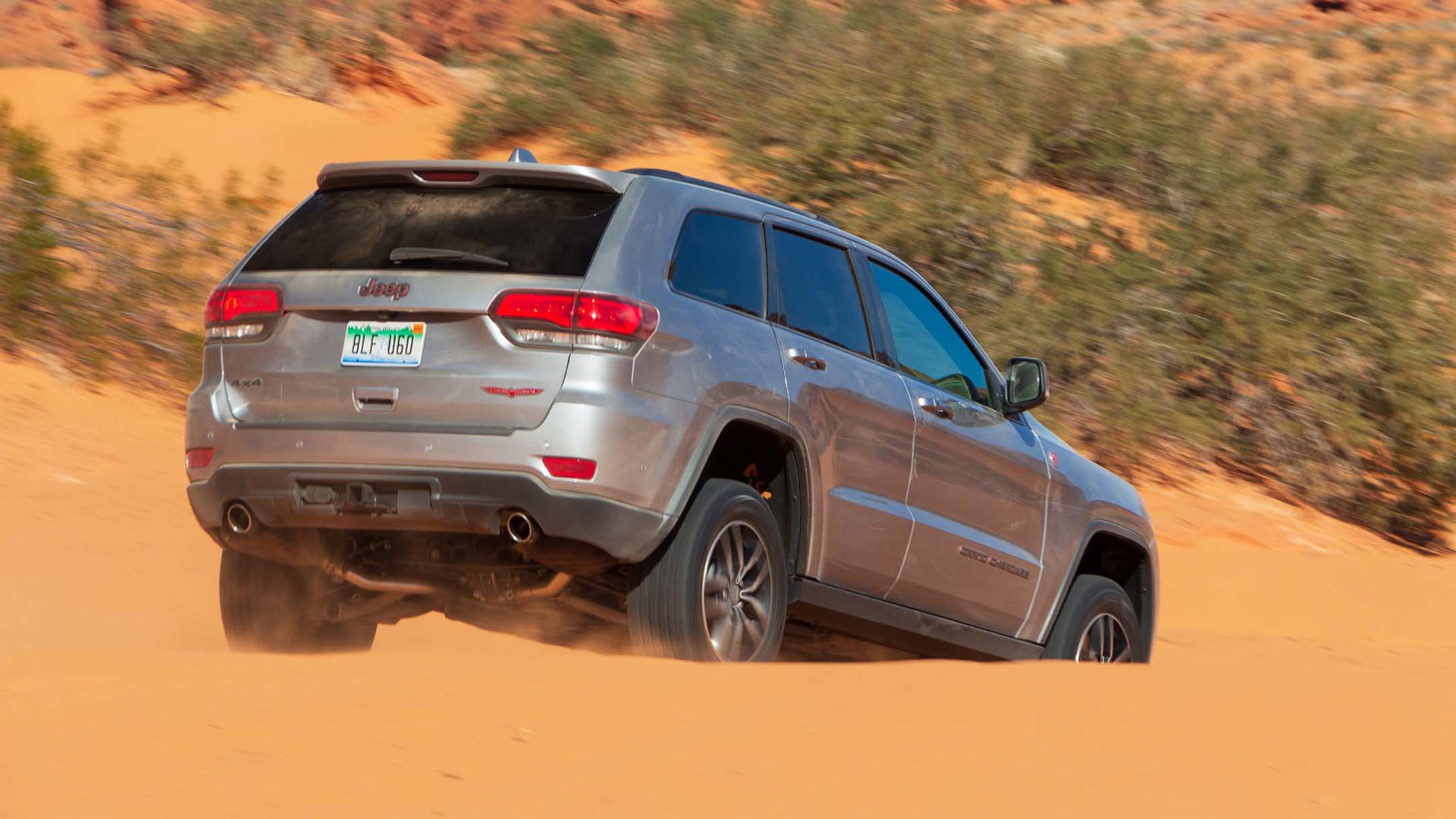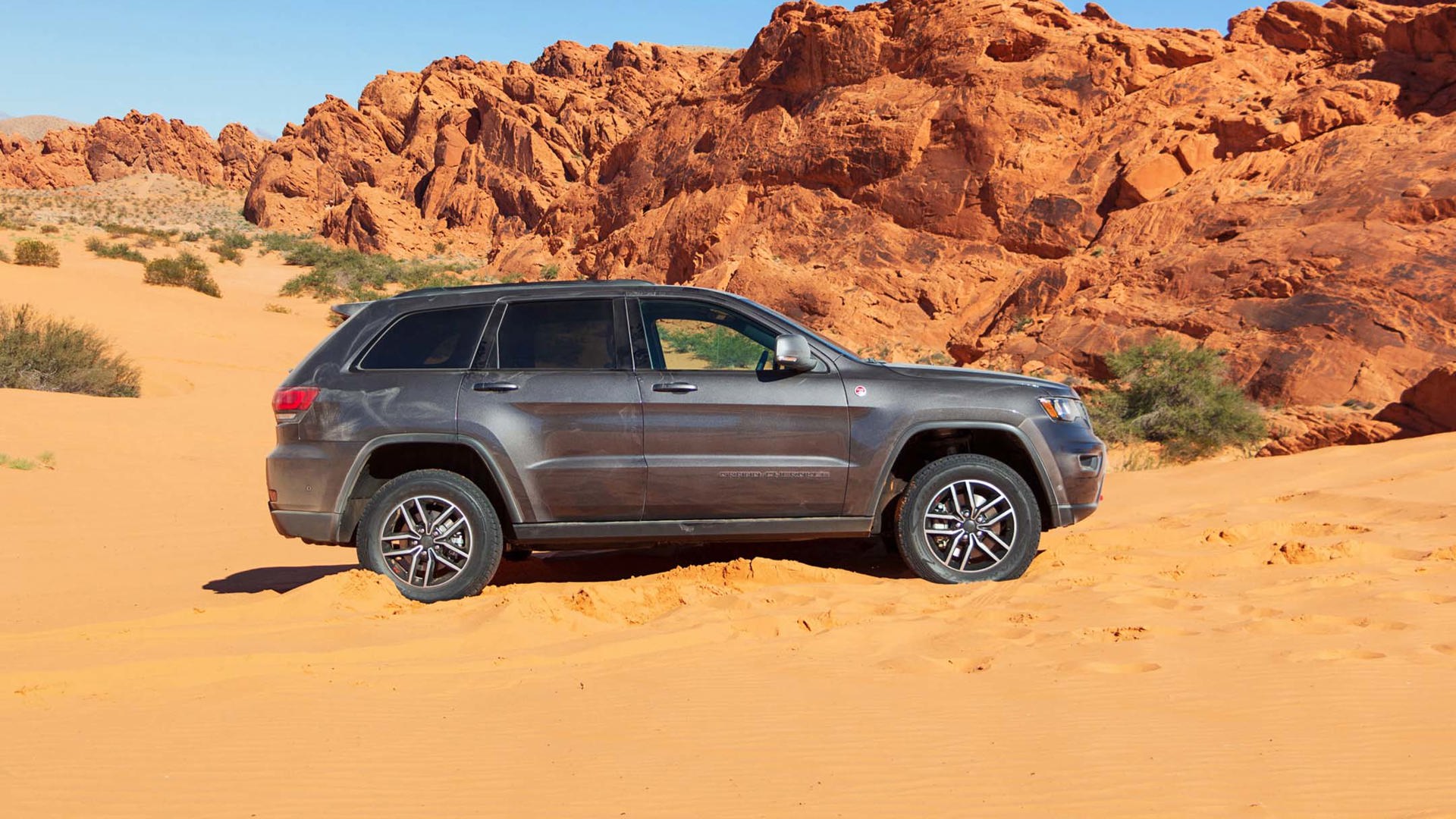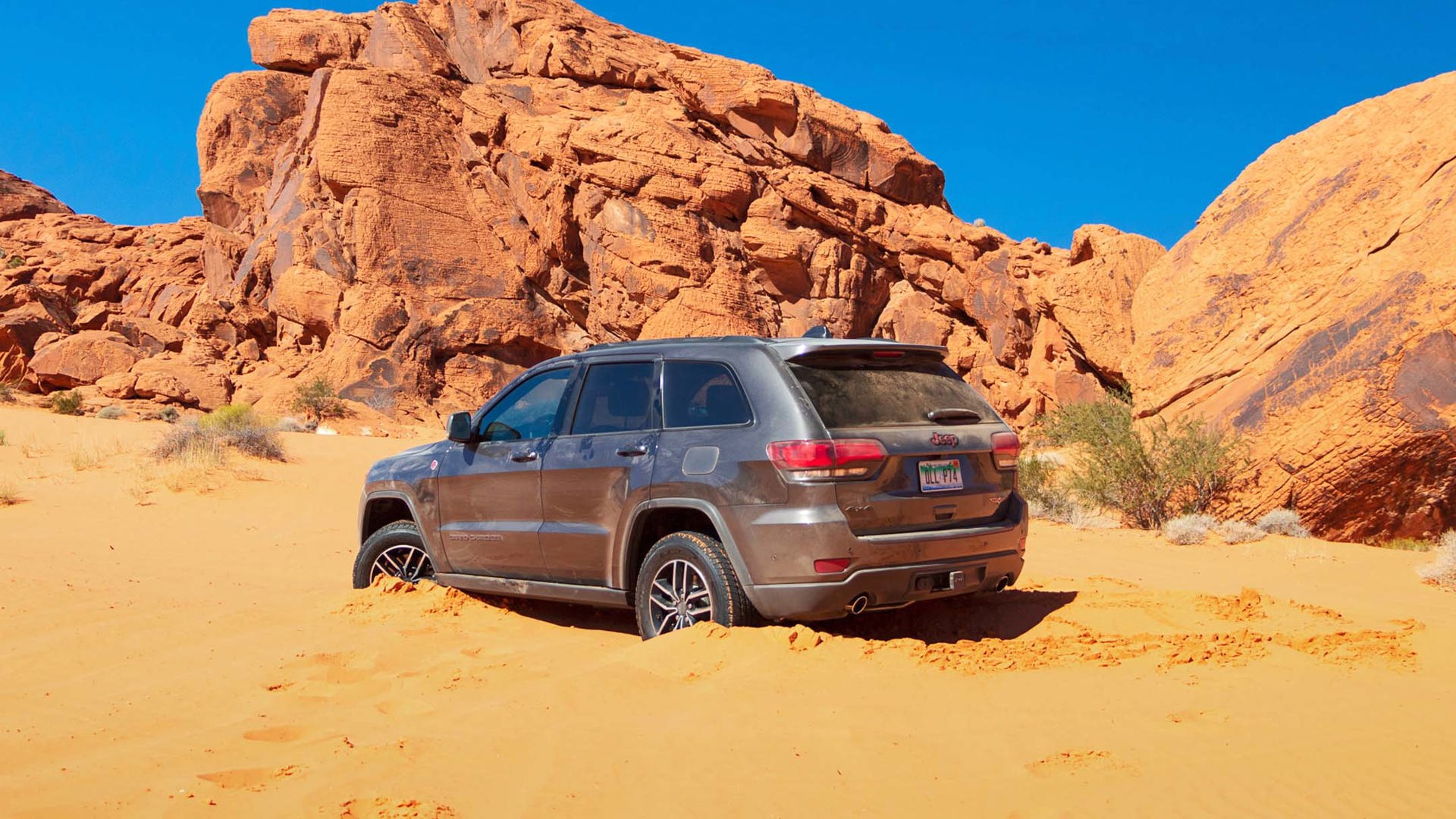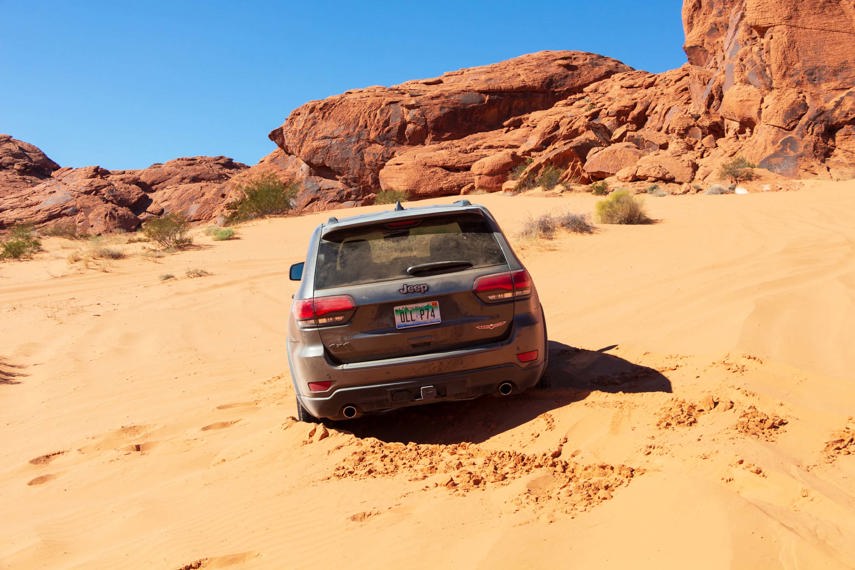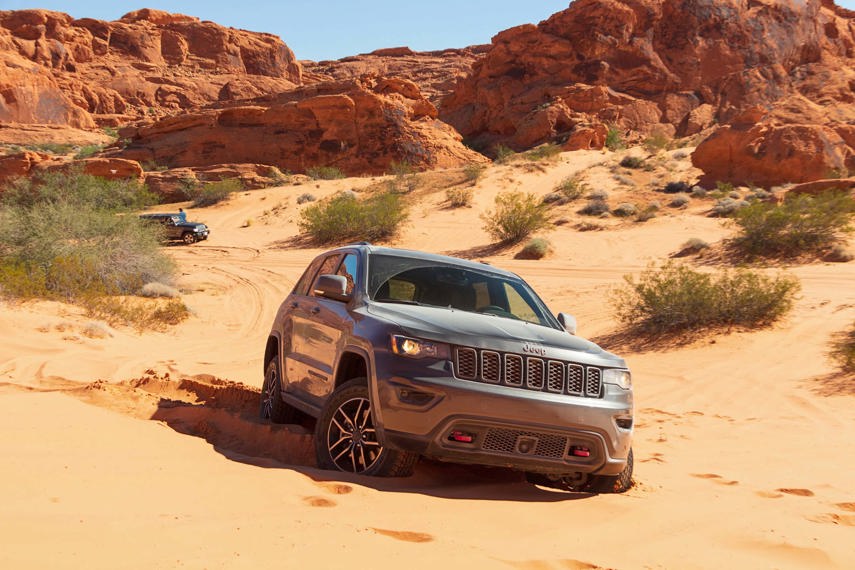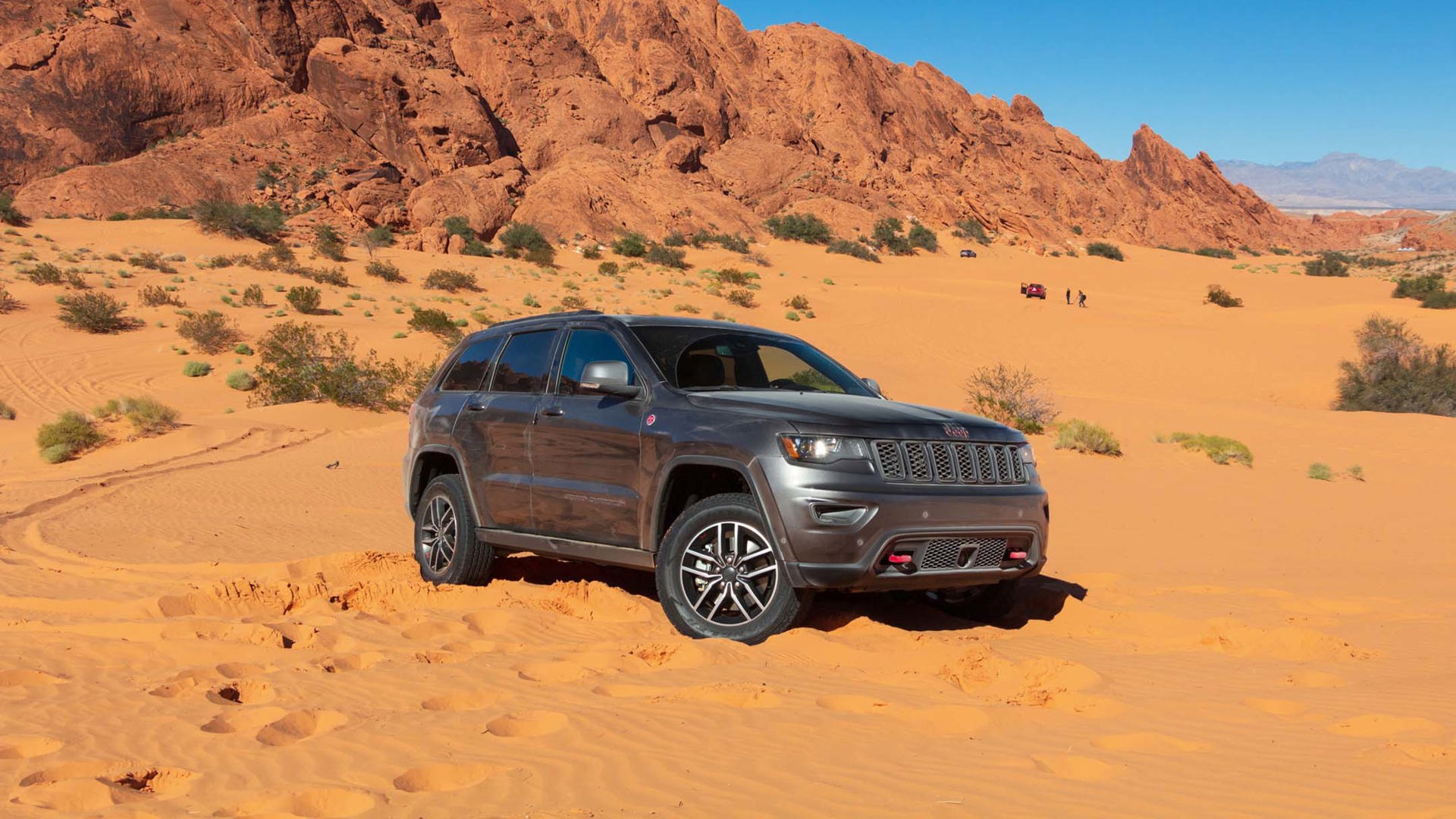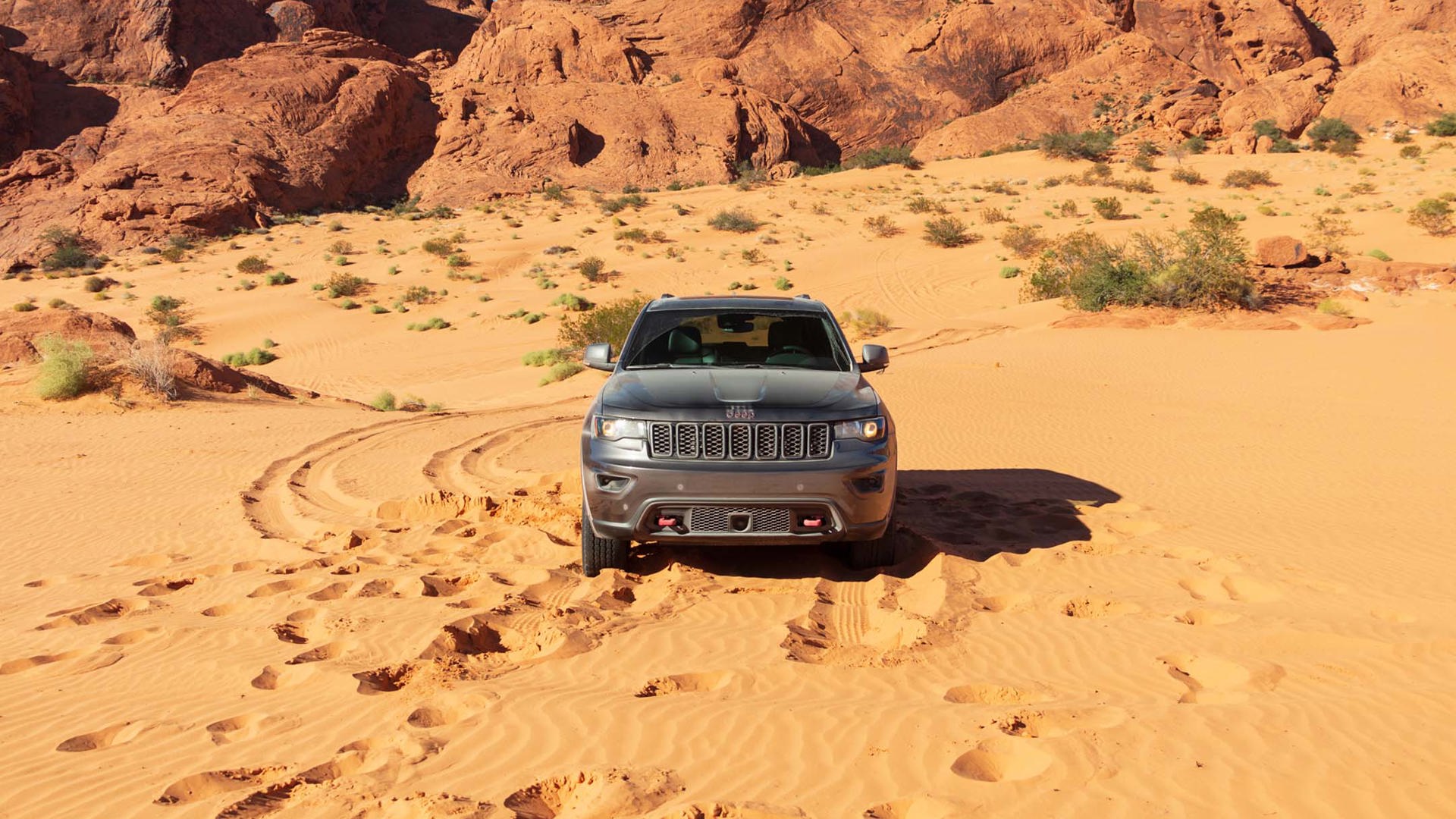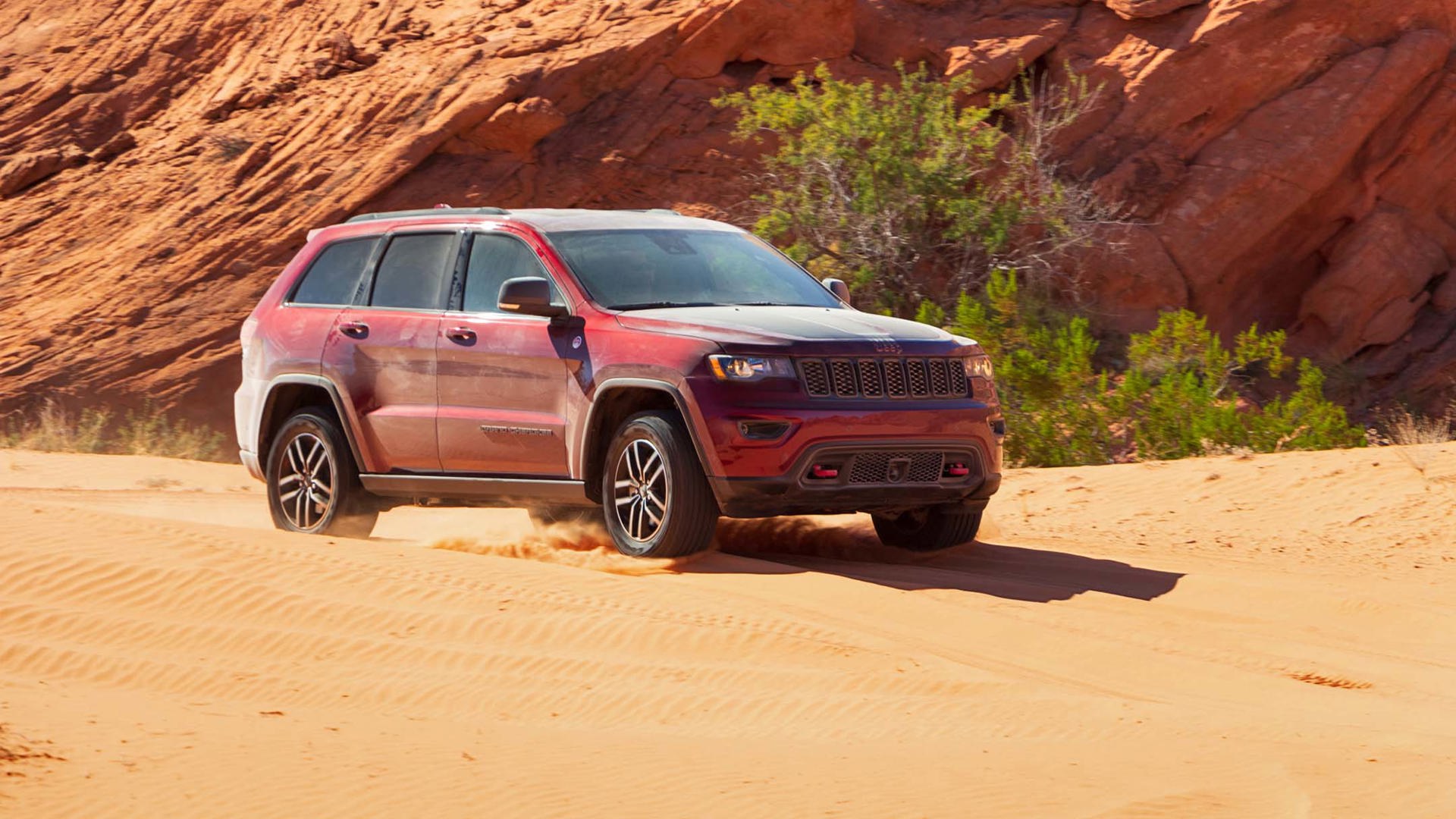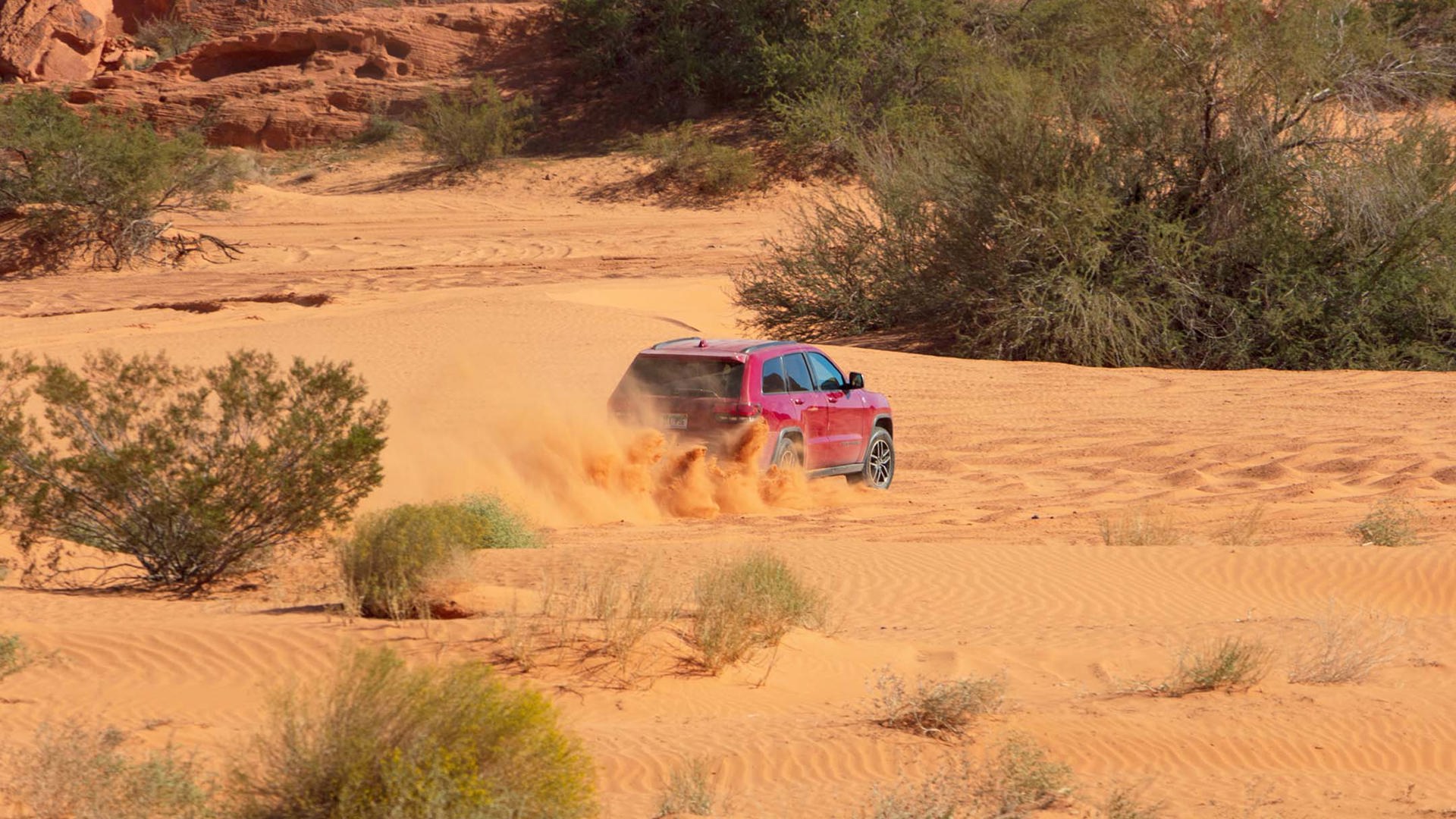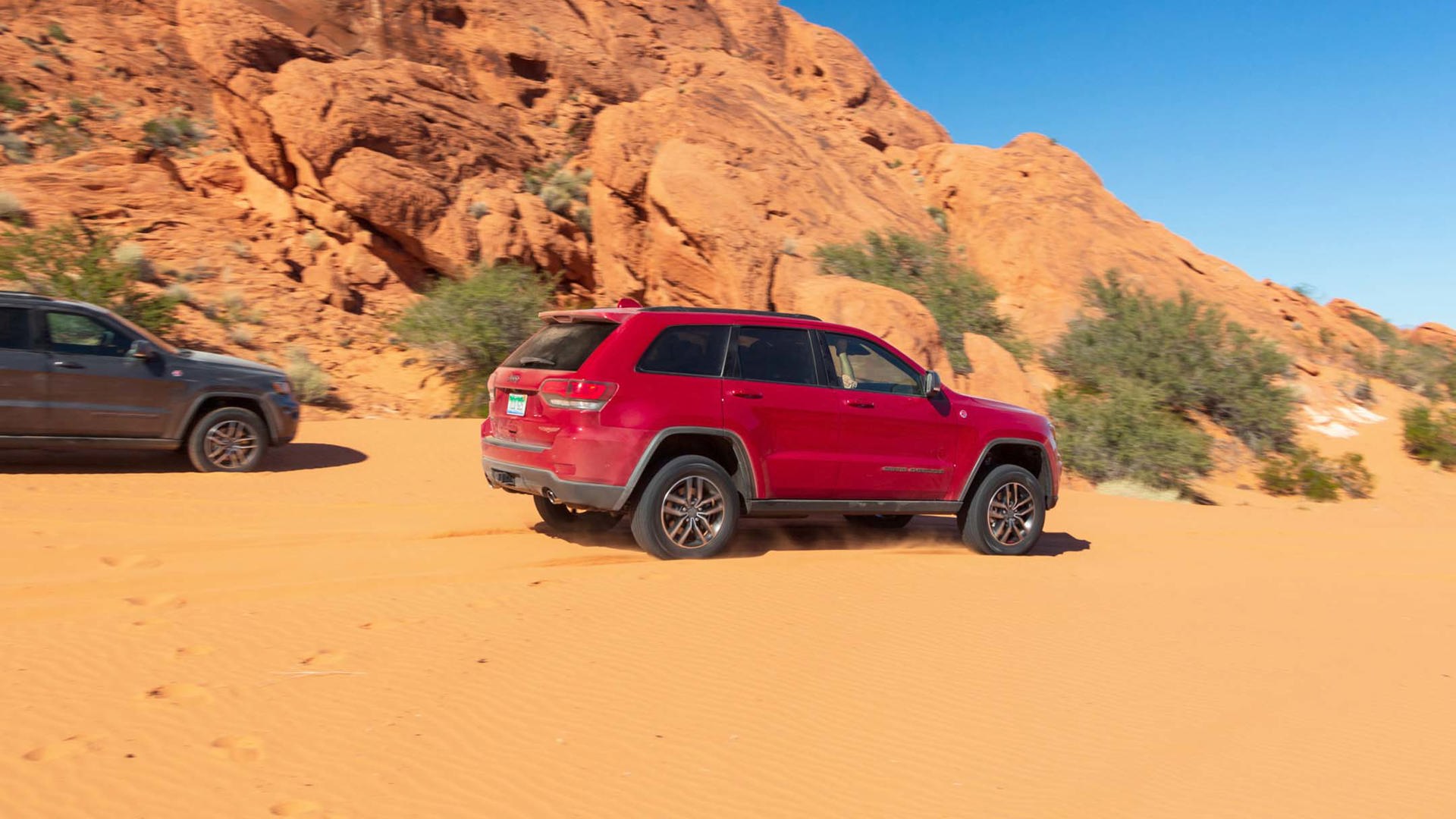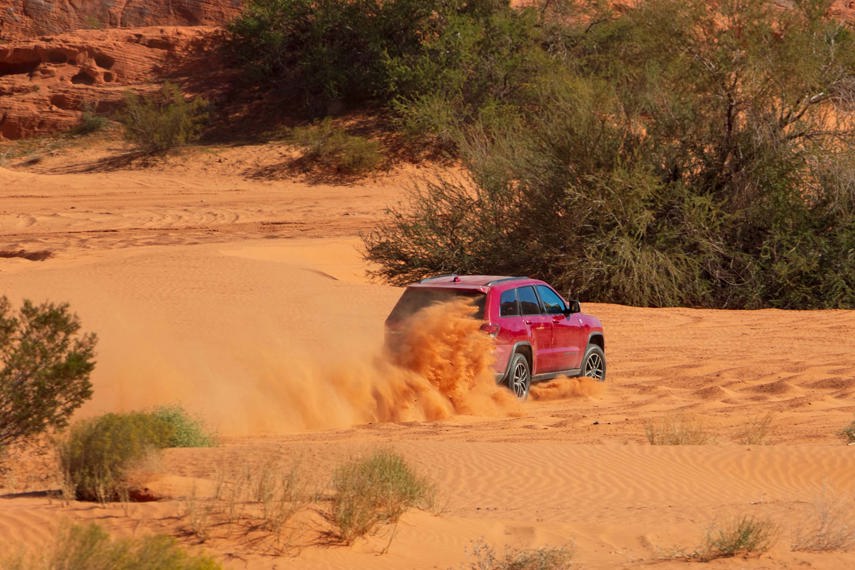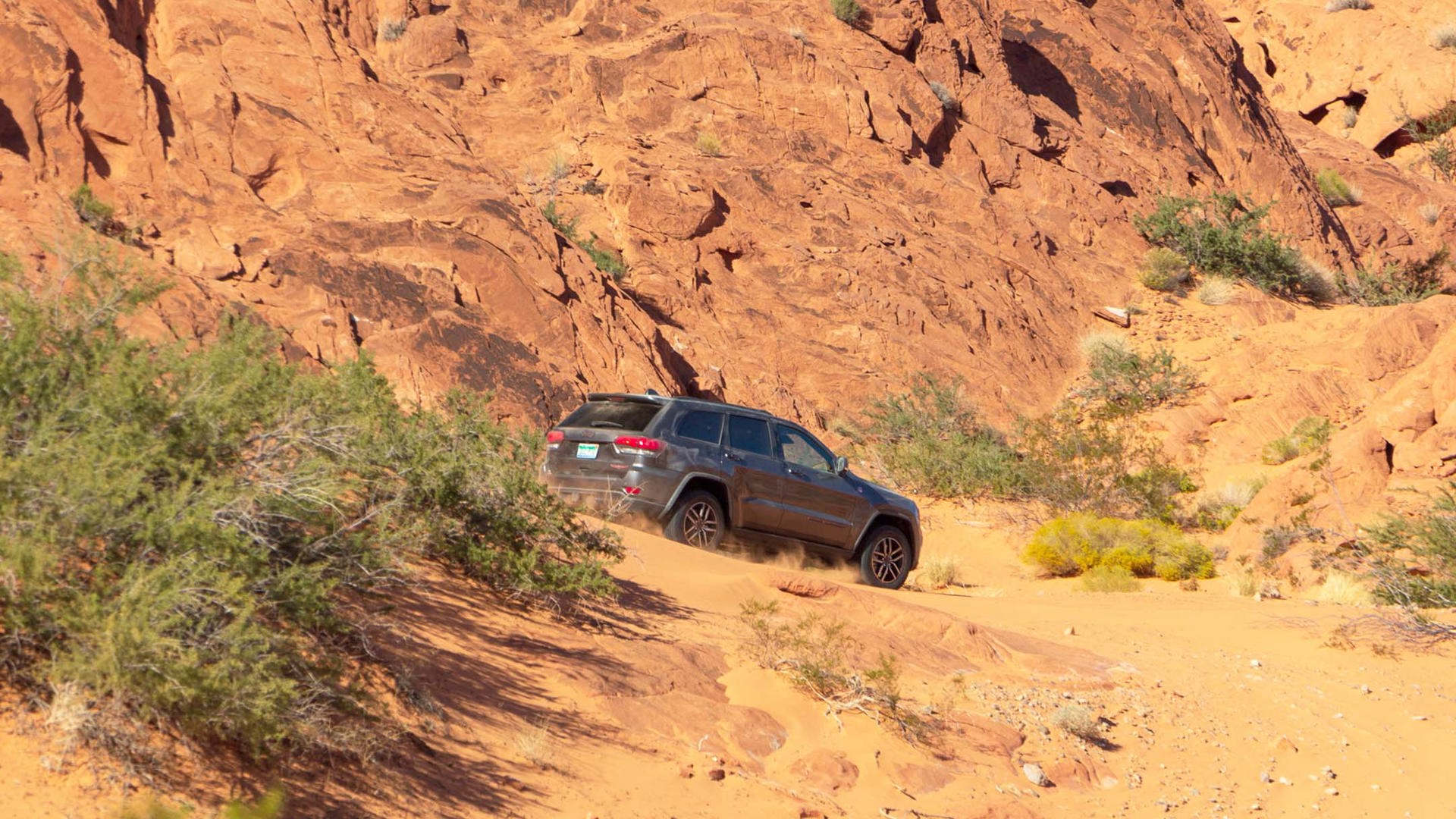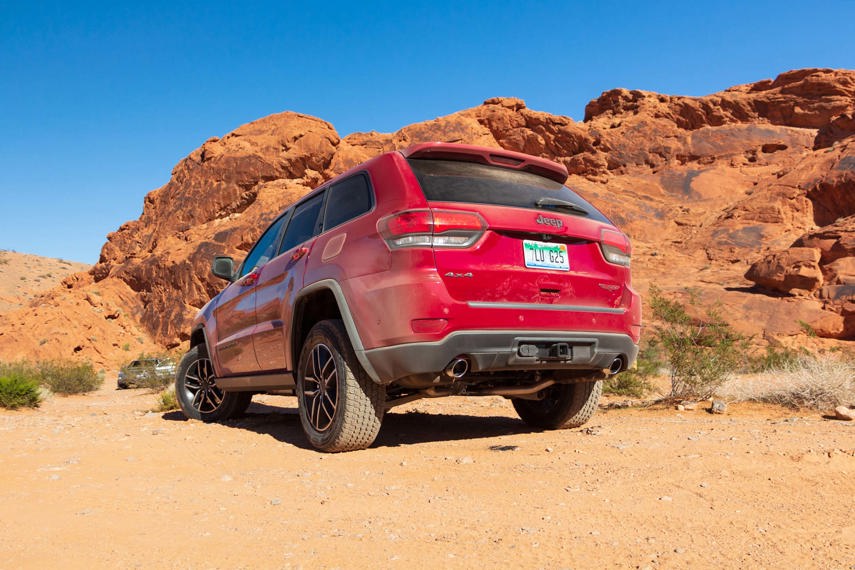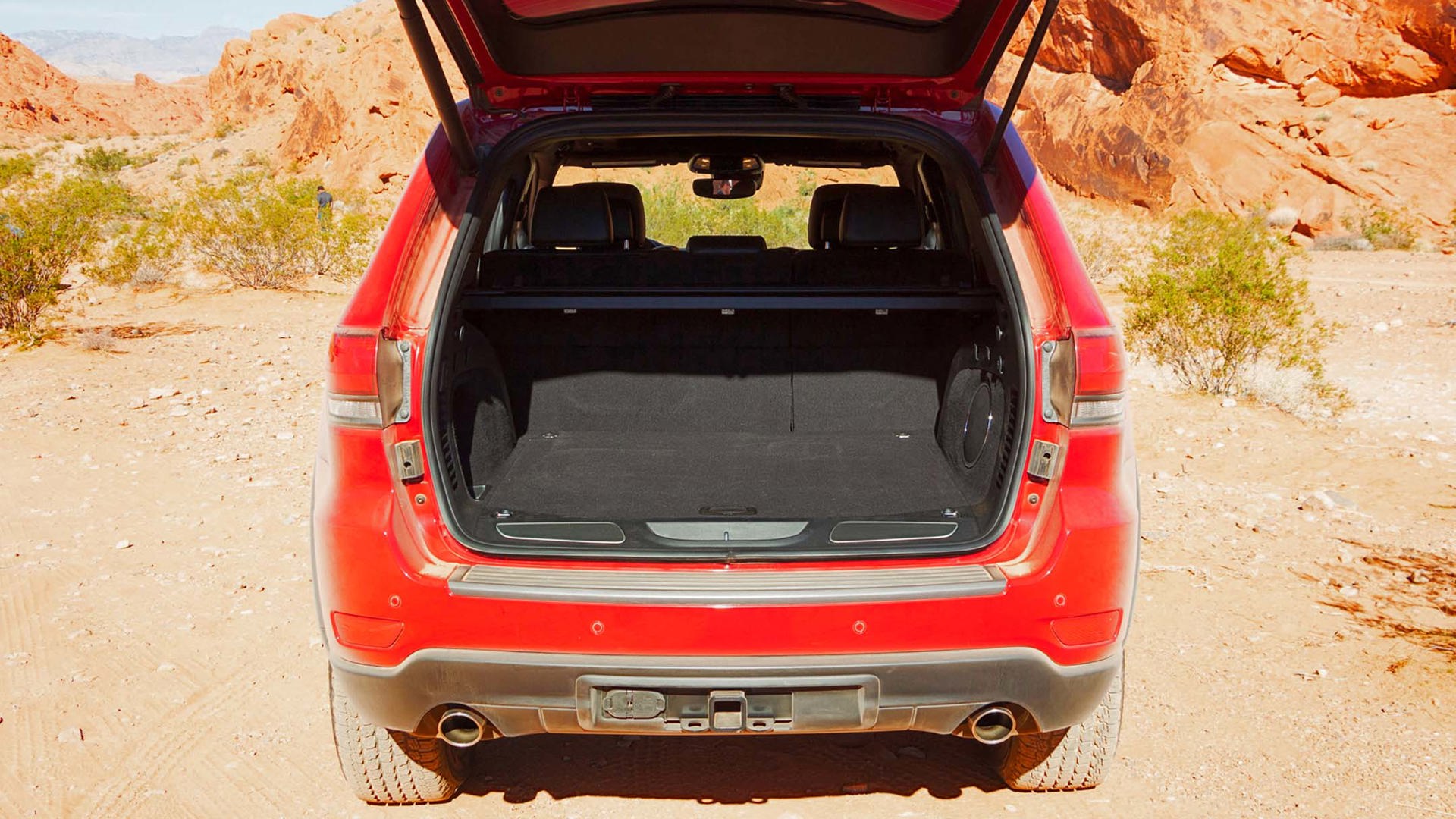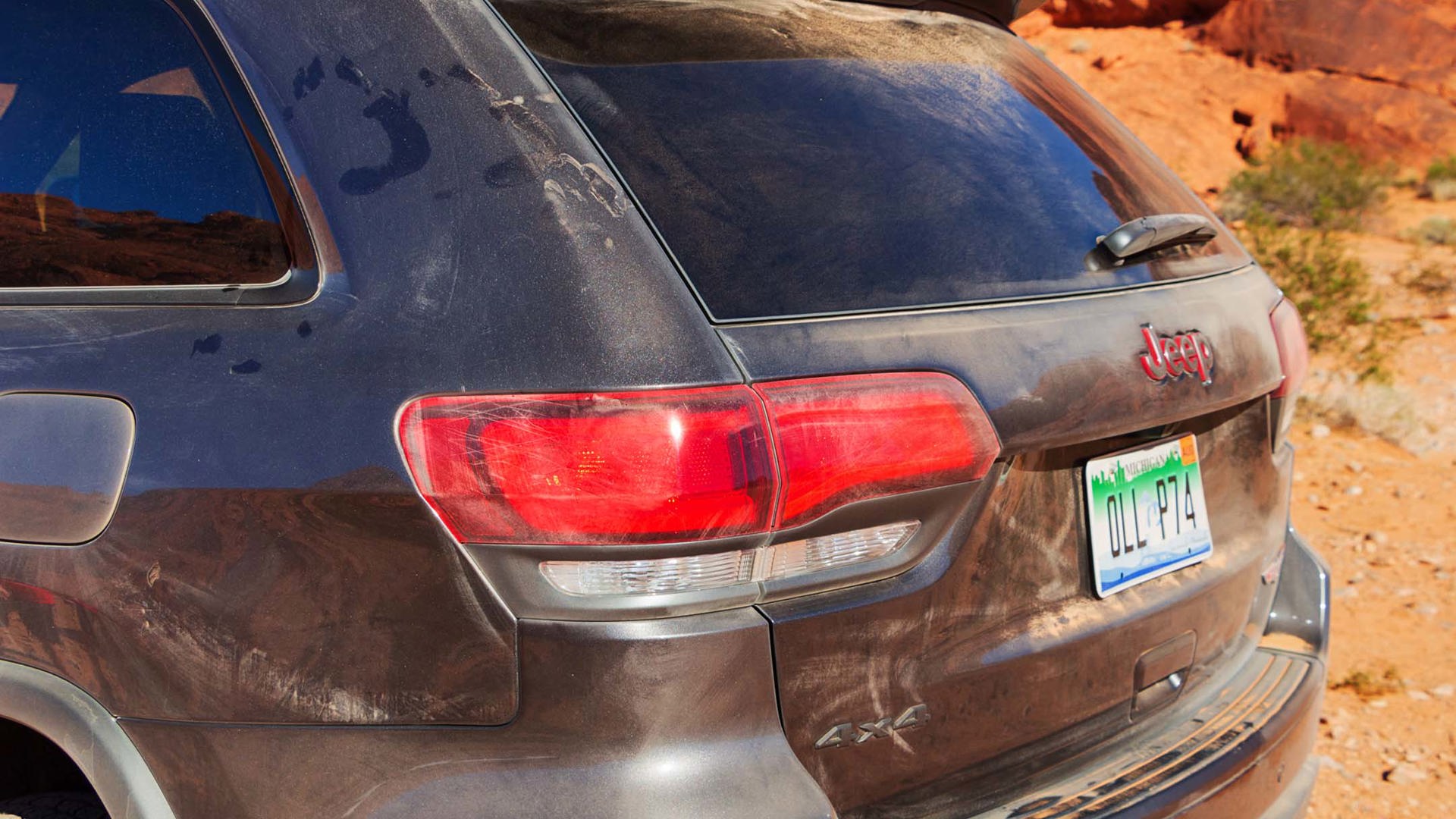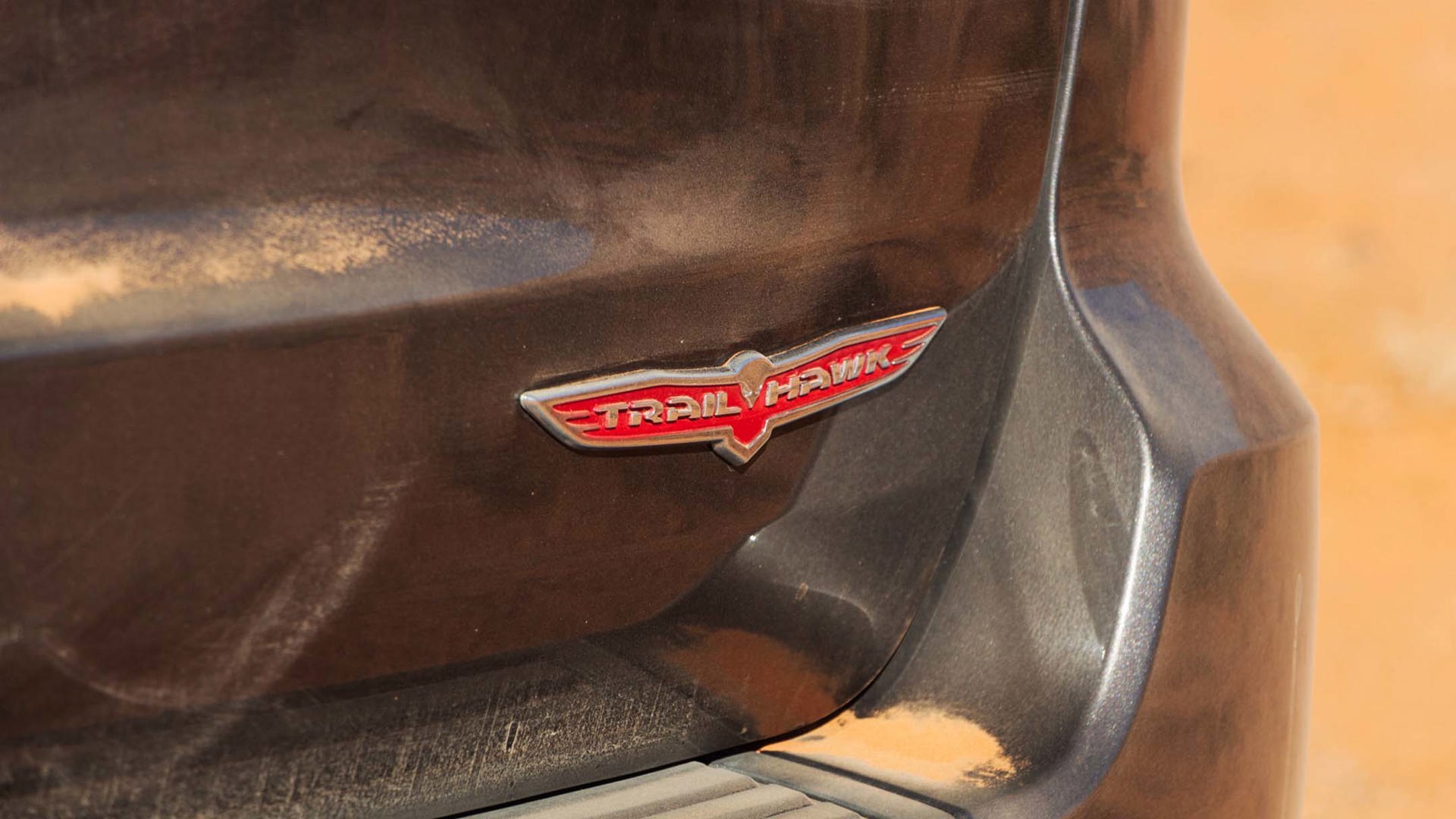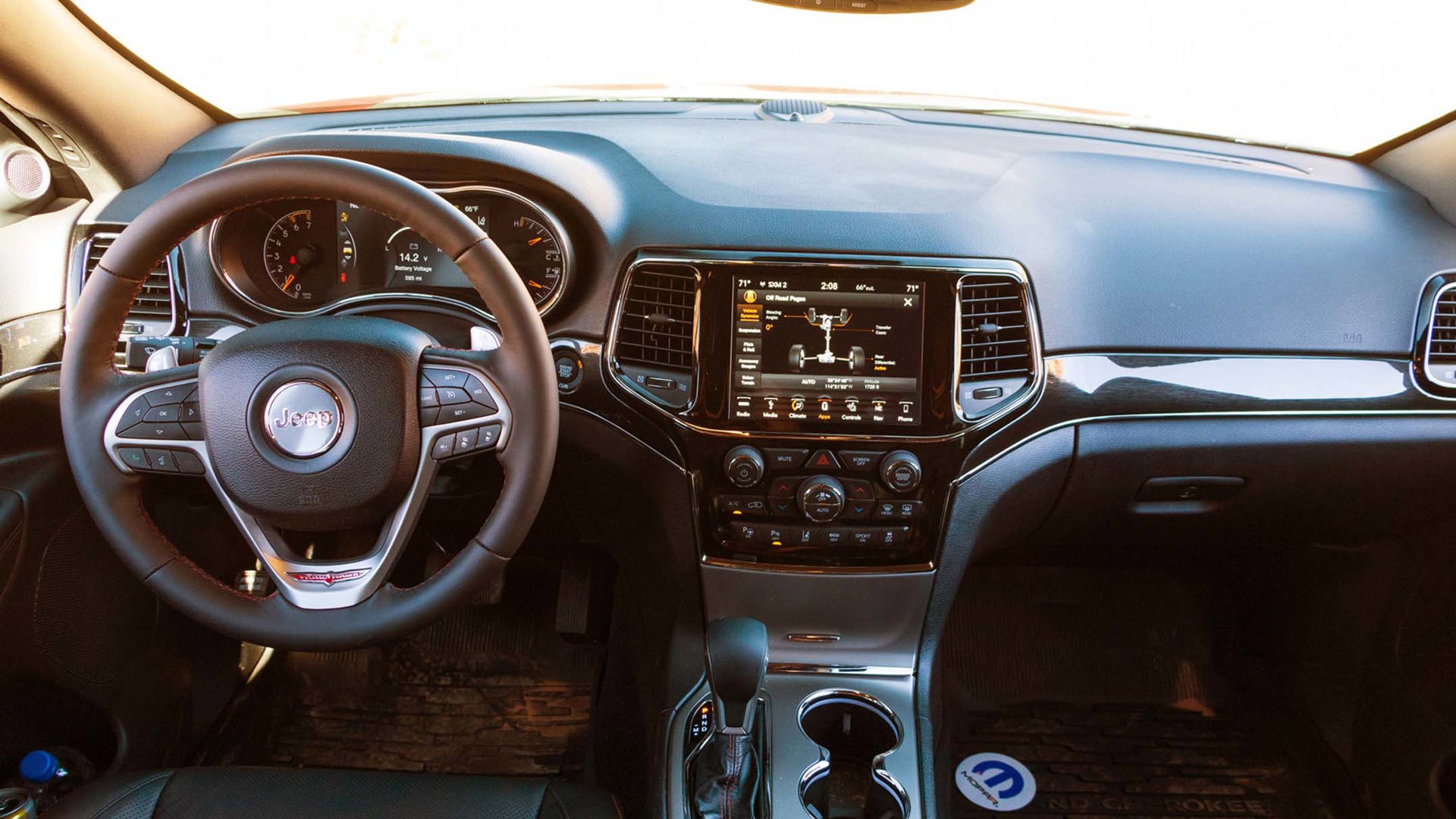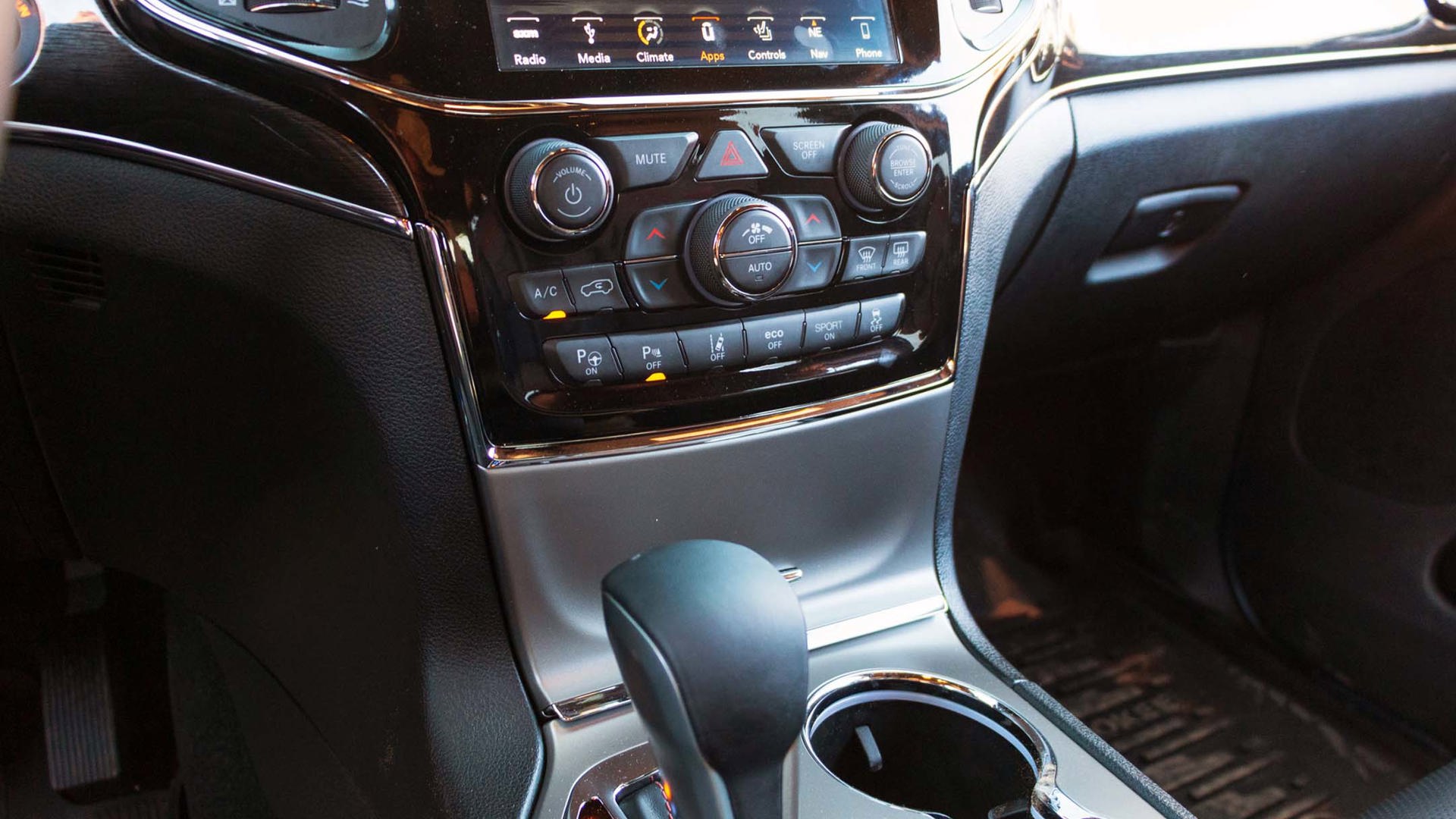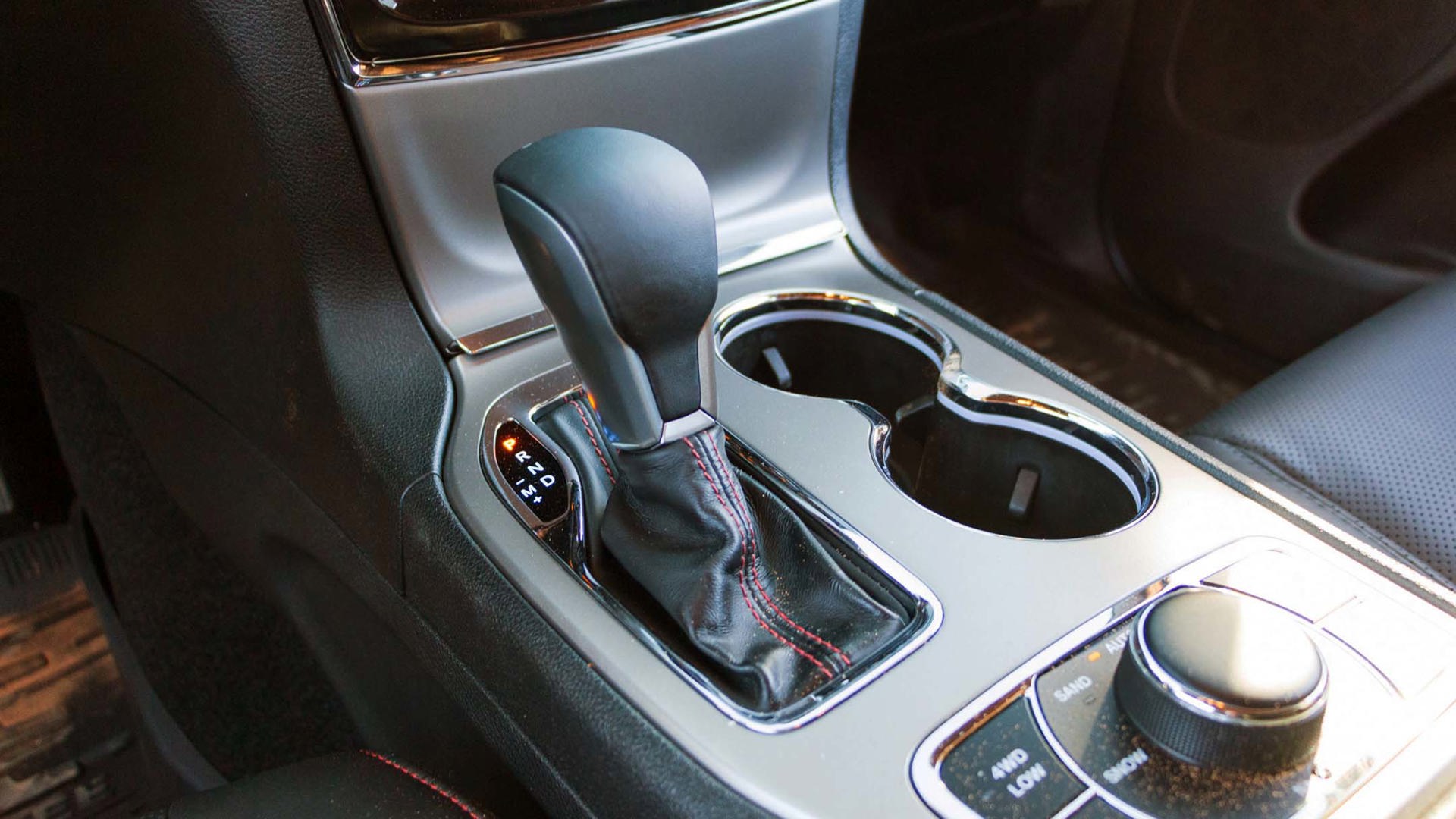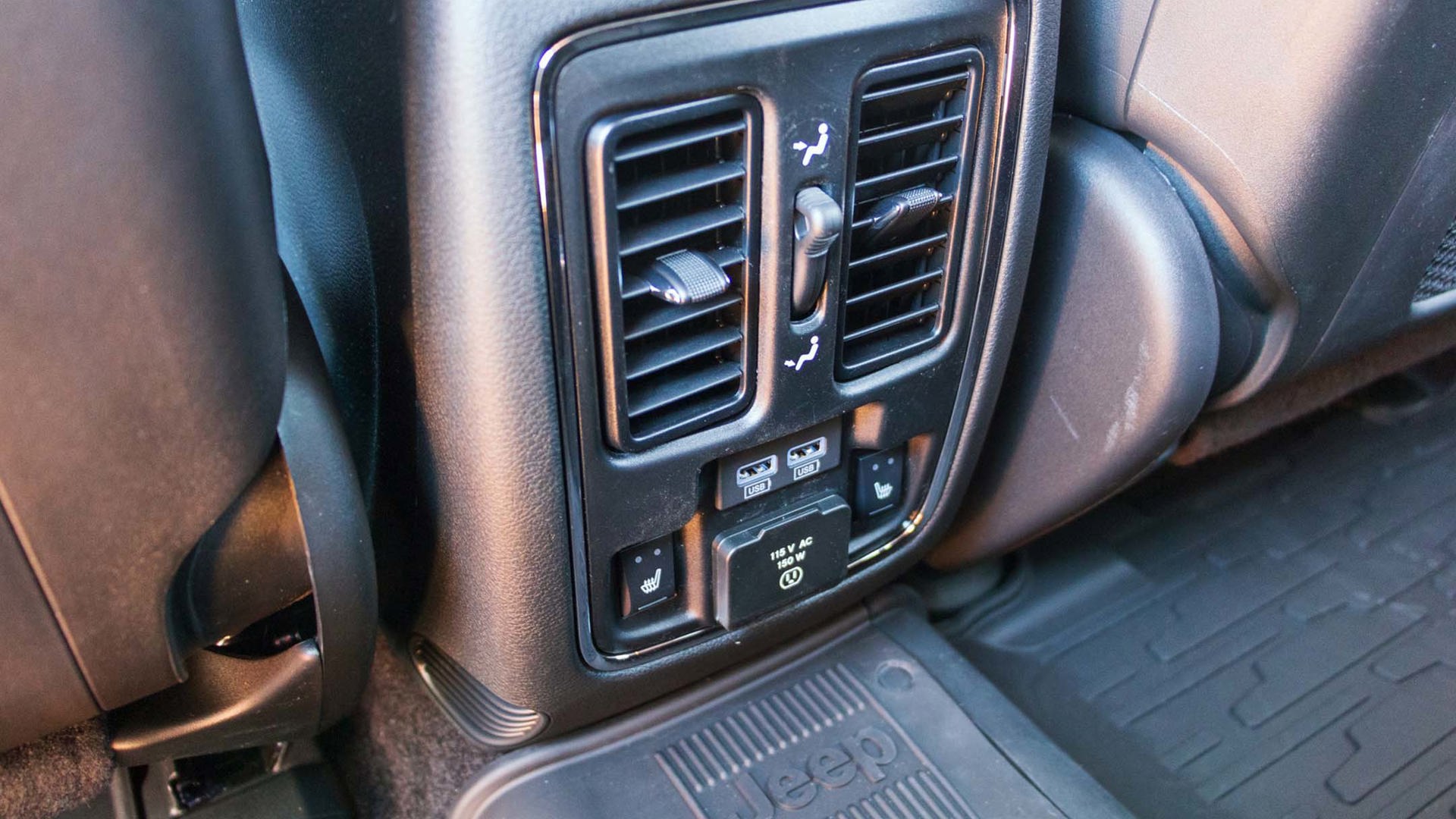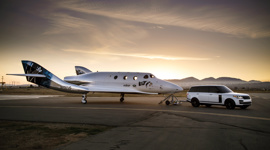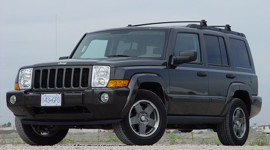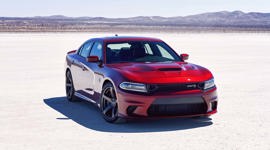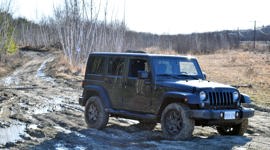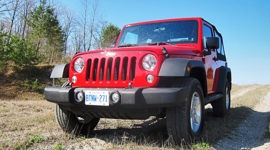31 degrees. It doesn’t seem like a steep slope until you’re sitting behind the wheel of a two-tonne SUV staring straight up at the sky, completely unable to see any piece of the rock wall that you’re supposed to be climbing. It’s even scarier when you’re headed back down, the locking seatbelt retractor the only thing keeping your nose from becoming one with the windshield. Driving safely up and down rock faces better described as cliffs seems impossible. Which is why Jeep brought us to Nevada’s Valley of Fire State Park to show us just how possible it really is.
I’m not sure what’s more difficult, the act of clambering up that rock face or truly understanding just how steep it really is. 31 degrees is a 60 percent grade, that means that for every metre you go forward you’re going up 60 cm. It feels like it’s straight up and straight down. Your windshield is showing either sky or ground, nothing in between.
![]()
That’s what we saw from behind the wheel of the Jeep Wrangler Rubicon and that slope is what was indicated on the in-dash off-road display. We’re pretty sure that the actual peak slope of the hill was even steeper, but it’s tough to keep your eyes on that gauge when you’re expecting to roll over backward at any moment.
Part of what makes a Jeep a Jeep is the ability to crawl over rocks, boulders, and just about any obstacle in the way. But it’s the kind of capability that’s difficult to understand without a team of experts pushing you to test not the limits of your confidence but the limits of the vehicle. The latter is much higher than the former.
![]()
It’s much different than the experience of driving a fast car. Almost anyone can sit behind the wheel of an 808 hp monster like the Dodge Demon and experience every single one of those horses. Mat the gas and the vehicle erupts in noise and either acceleration or tire smoke. Take the same car around an on-ramp quickly and the cornering performance is again easy to feel.
But drive down a rutted road and you aren’t even scraping the edges of the capability of a real off-road vehicle.
If the harshest terrain your SUV has ever seen is a rutted cottage trail, you’re not even close to “off-road”. Jeep has built its brand by encouraging owners to push those limits and discover that plodding along at 2 km/h can be a more challenging and high-performance drive than taking a fast car to a racetrack.
Climbing Rocks in the Jeep Wrangler Rubicon
![]()
While every Wrangler is loaded with off-road and 4x4 features, the Rubicon is the most hardcore of the bunch. Like Jeep’s M3 to the 330i sedan. Or the Challenger Hellcat Redline to the V6-powered SXT.
Like all high-performance vehicles, that means high-performance tires: BFGoodrich AllTerrain T/A KO2. The KO means Key Feature: Off Road. These are tires designed for maximum stick when the pavement is kilometres behind you, as well as the durability to stand up to poking and prodding from sharp rocks. The 33-inch diameter helps the tires to roll over obstacles instead of dropping down into them and also helps the tires to get on top of rocks instead of underneath them.
![]()
The suspension offers up 277 mm of ground clearance. That’s enough to comfortably roll a basketball – or a basketball-sized rock – under the Rubicon. Added to that, the wheels can move up to 20 cm, enough to keep them on the ground long after you would expect them to be spinning in the air. The front bumper lets you approach obstacles with up to a 44 degree angle and drive off 37 degrees on departure. It means that while you’re terrifying yourself driving down a rock face, you don’t have to worry about scraping the bumpers when you eventually return to level ground.
Sway bars transfer forces between the two tires on an axle and stops the vehicle from rolling in turns. That makes for better stability on the highway. But off-road, it stops the wheels from conforming to the terrain you’re trying to drive over. It’s trying to keep the axle level when you want it to let one wheel go up and the other down. It’s why most SUVs teeter with a wheel in the air on even a small terrain change.
![]()
Electronic sway bar disconnects on the Rubicon disengage the bar and let the wheels use more of their suspension travel. If the left wheel is trying to climb a rock while the right is on flat ground, the left wheel can go up and over while you stay comfortable and mostly level. Letting the springs carry the load instead of the roll bars makes for a ride on barely marked trails that’s better than that of most SUVs on a flat dirt road.
The Rubicon’s Rock-Trac 4x4 system lets you electronically lock both front and rear differentials when it’s dropped into low range. That means that when the low-range transfer case multiplies the engine torque by 77.2 times, all four wheels turn – even if one is in the air and another is in loose sand. That low range gives enough of a torque boost to let the Jeep drive on all but the steepest hills without using the pedals. It just pulls itself along at about 2 km/h, up hill or down.
![]()
Jeep has staffers from the Jeep Jamboree crew out to help us pick our way through the trail’s seemingly insurmountable obstacles. The off-road spotter is crucial when you can’t see where your tires are and where they need to be. Like having an instructor in the right seat on an unfamiliar track, these spotters are amazingly helpful in inspiring driver confidence.
They’re also the only reason we’re trying to make it through gaps that leave enough room for a sheet of paper between fender and rock. Without their confidence, we’d be sitting back at the base camp with the air conditioning running and a cold bottle of water instead of experiencing the fear and elation of dropping off of a blind cliff without plummeting to earth.
![]()
A chorus of scrapes, clangs, and thumps echoes through the canyon. It’s the sound of fresh and expensive paint being deposited on 150-million-year-old sandstone. Except that the rock rails and underbody skid plates take the blows, protecting that expensive paint and soft underbelly items like the fuel tank and the oil pan.
We keep climbing over ever bigger and more intimidating rocks and boulders while threading our way up and down hills through ever-narrowing gaps. While a wrong turn of the wheel isn’t likely to damage car or driver, it definitely feels like straying far to either side of the trail will end with an upside-down Jeep and a removable hardtop that’ll now be covered with empty water bottles and snack wrappers. That’s when having a good spotter to guide you is essential, and the Jeep Jamboree folks are pros; guiding off-road drivers is their day job.
Speeding Over Sand in the Jeep Grand Cherokee Trailhawk
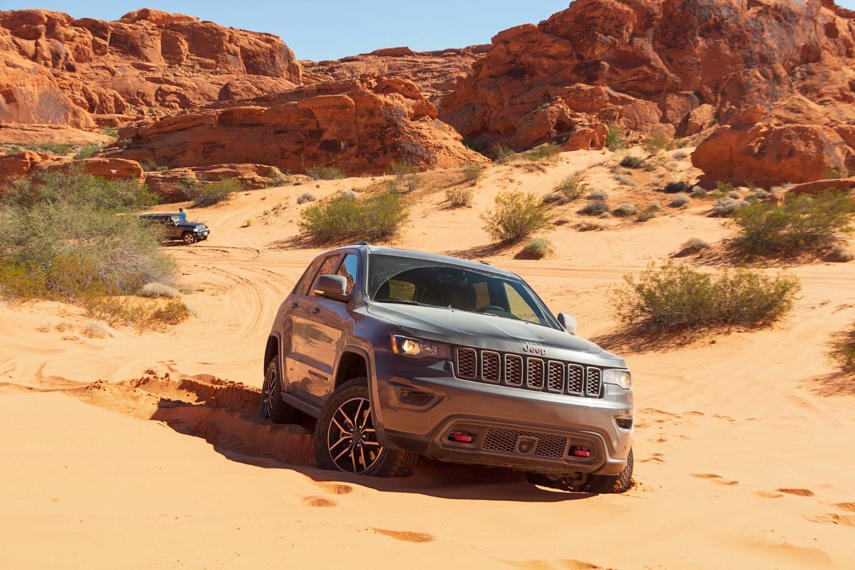
But spending two hours to drive fewer than five kilometres isn’t everybody’s cup of off-road tea. So Jeep brought some Jeep Grand Cherokee Trailhawks along for the ride.
Instead of the narrow and tight rock crawl, the Trailhawks were bound for the sand. Fine, red sand that was more than eager to suck down the tires of unsuspecting passersby. Or the shoes of intrepid journalists, which lead to a distressing amount of that sand being poured from my sneakers by the end of the day.
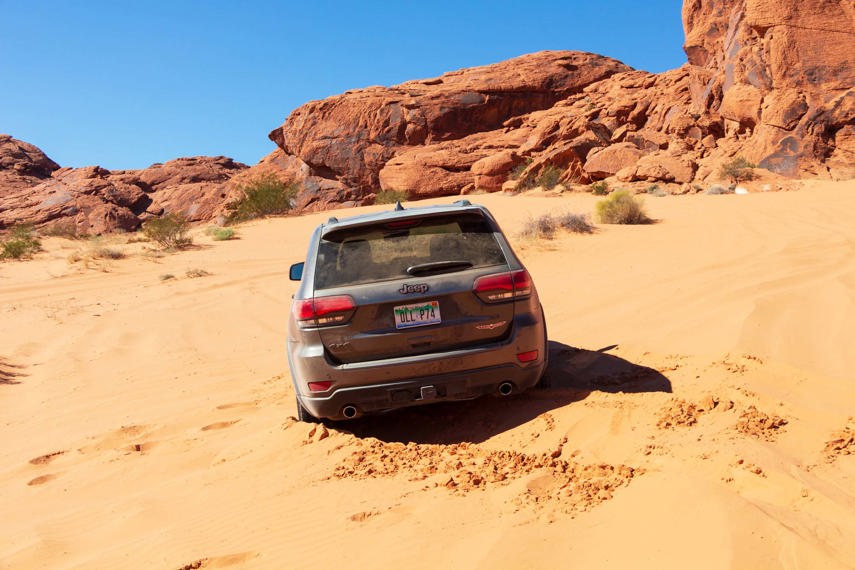
The Trailhawks get an air suspension that offers more travel and increased ground clearance compared with the standard Grand. Which is exactly what we needed, since dips and drops in deep sand are much bigger than they appear. Like snow, they mask your usual depth perception, making it easy to come in a little too hot. And when you’re using the full-time all-wheel drive system and 5.7L V8 to power through the sand, they come up much more quickly than you realized.
Fly through the sand at speeds that feel far too quick and the Trailhawk’s specially contoured seats hold you in place better than those of lesser Grand Cherokees. The suede inserts might not especially help to this end, but they look and feel good enough that it doesn’t matter.
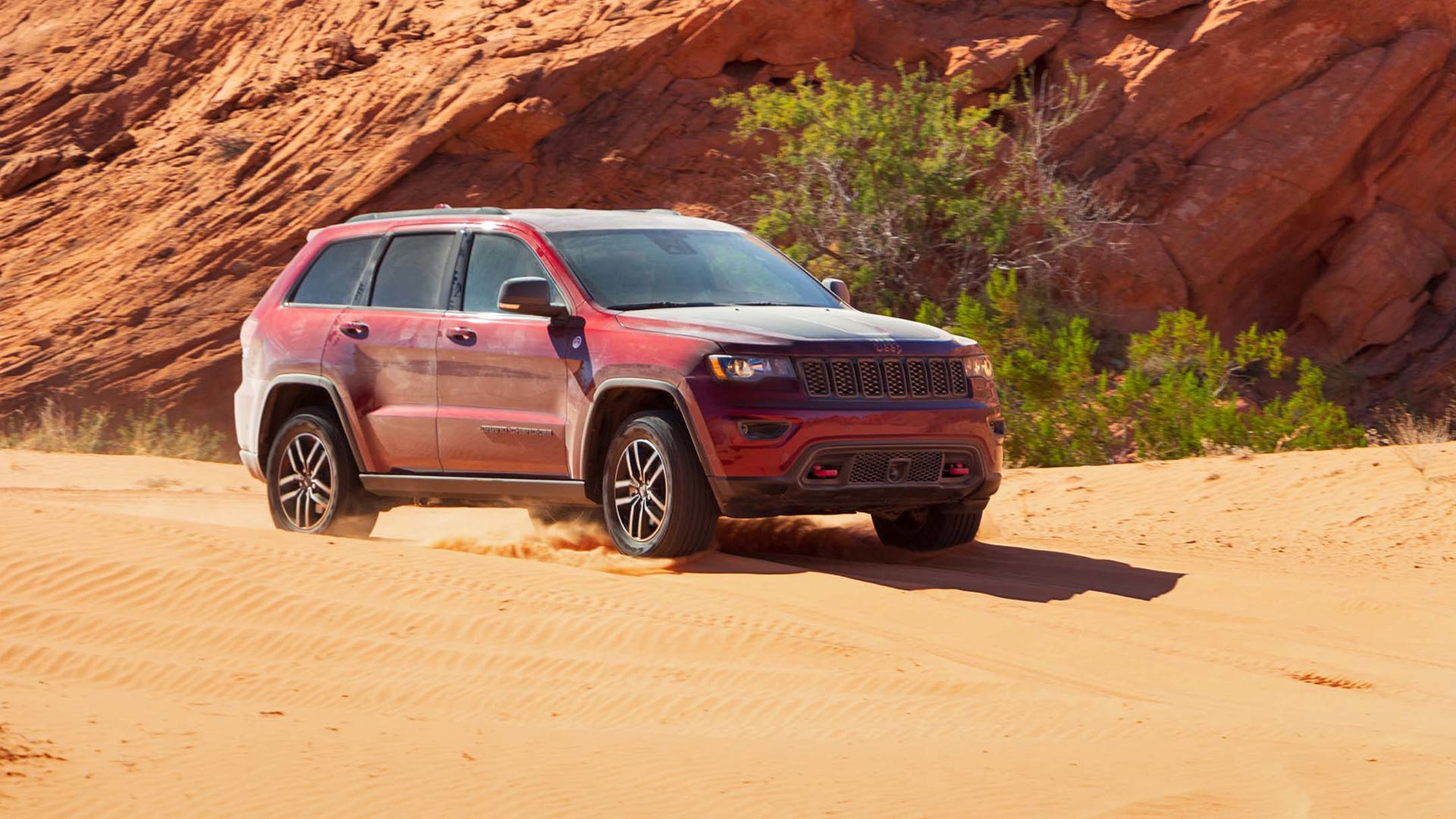
While rock crawling is an exercise in not using the throttle, driving in deep sand demands that you keep the car moving. Momentum is crucial. Stop and you risk sinking into the surface, where the Goodyear All-Terrain tires just help you dig yourself deeper into the sand. Which, of course, we managed to do.
Driving on sand is like driving in deep snow. Only it’s a whole lot warmer if you need to dig yourself out or push. Let the vehicle move around more than you would on pavement. Guide it along the path and it will go where you want it. Braking distances are similarly stretched. The low-traction surface doesn’t offer braking grip until the tires start to push sand ahead of them. Then they dig in and bring you to a quicker stop.
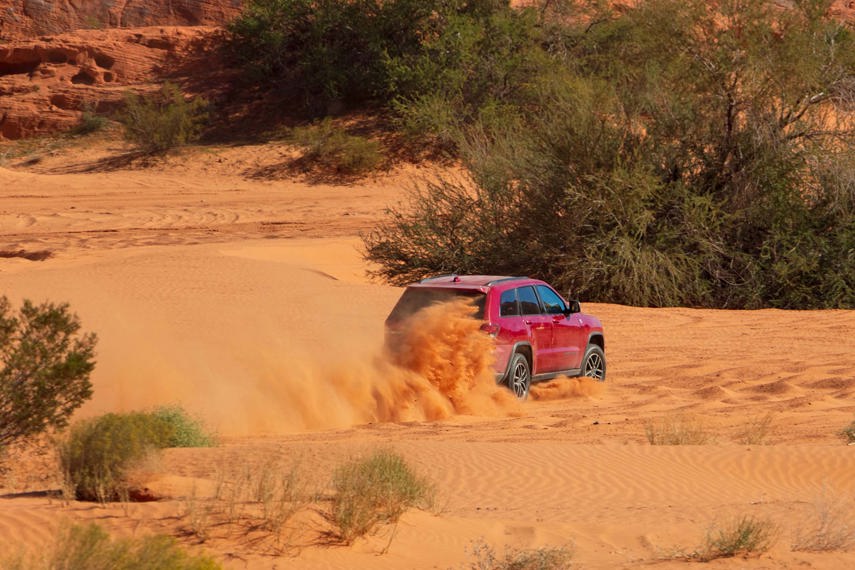
Keep the gas pedal down and the speed up and the Trailhawk can climb dunes that look steeper than any SUV should be able to climb. Turn the wheel and keep on the gas and it will power back down the other side as well. With the tail swung out and the Grand Cherokee leaving four rooster tails of sand in its wake.
This isn’t a machine set up to hammer over sandy road jumps at speeds that will put it airborne, it’s designed to be able to handle these roads at speeds that are much more reasonable. That’s still more than quick enough to be fun – feeling the wheels scrambling for traction, picking out routes that won’t put you into sand too deep for the ground clearance, and counter-steering as the rear end slides back and forth in the soft surface.
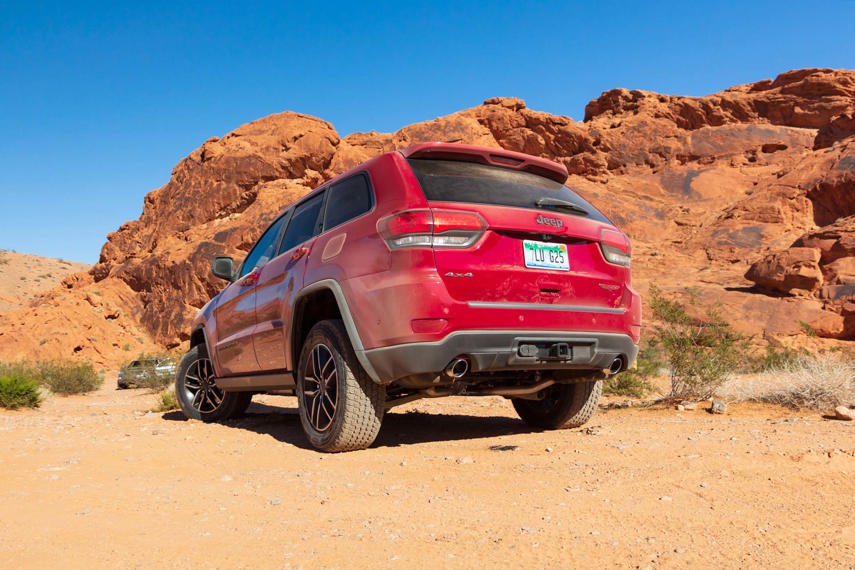
It’s easy to shy away from off-roading. It’s slow, it will bring out all the strange noises your SUV can make, and there’s a chance you can get stuck. That doesn’t mean it’s any less of a high-performance experience than any day at the racetrack. Don’t let those things steer you away from the road less travelled. Embrace them. Exercise your suspension and take it off-road. And if you’re in a Jeep Rubicon, you can probably take it a little further off of that road.
